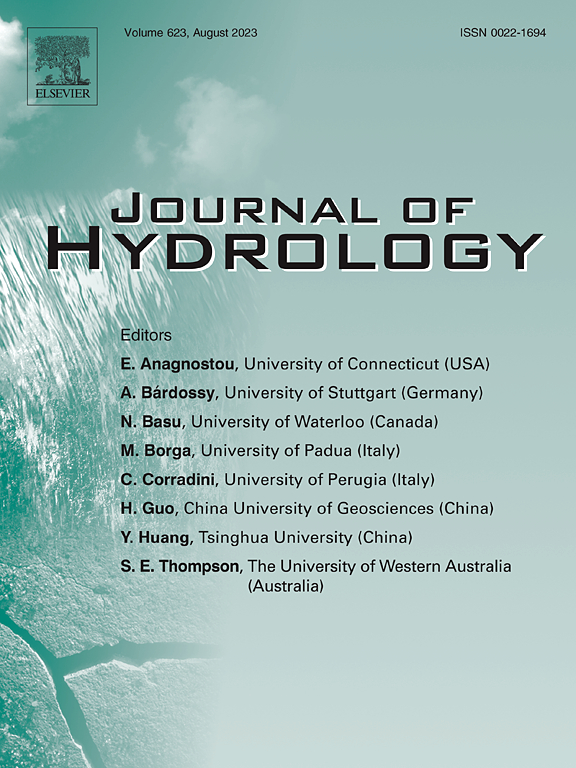用三维方法评价气象干旱对水文干旱的传播特性
IF 5.9
1区 地球科学
Q1 ENGINEERING, CIVIL
引用次数: 0
摘要
在全球气候变暖的背景下,极端干旱事件日益频繁,给工农业生产造成严重损失。研究气候变化背景下的干旱特征变化是应对干旱风险和减轻重大影响的关键。然而,传统的基于网格数据的干旱识别方法不足以捕捉干旱事件的发展特征。因此,我们需要采用三维干旱识别方法来描述干旱事件的演变过程。我们改进了现有的三维干旱识别和匹配过程,通过比较历史和未来时期的干旱特征,构建了干旱特征传播指数(DCPI)。这使我们能够比较黄河流域在历史和未来时期的干旱传播特征,并讨论其稳健性。结果表明:(1)改进的三维干旱识别方法可分别解决25.3%的气象干旱和39.8%的水文干旱的干旱识别连续性问题。(2)基于多模式集合的SSP370情景的气象干旱最可能引起水文干旱。未来,干旱将呈现加剧的趋势。未来干旱强度转换效率将提高64.3%,面积转换效率将提高54.2%,均高于历史时段。(3)多模型集与单模型集的结果存在一定差异,但均表明干旱传播较历史时段增强。本文章由计算机程序翻译,如有差异,请以英文原文为准。
Evaluating the propagation characteristics of meteorological drought to hydrological drought using a three-dimensional method
In the context of global warming, extreme drought events have become increasingly frequent, resulting in serious losses to industrial and agricultural production. To address drought risks and mitigate substantial impacts, it is essential to study the changes in drought characteristics under climate change. However, traditional drought identification methods based on grid data are inadequate to capture the developmental characteristics of drought events. Therefore, we need to adopt a three-dimensional (3D) drought identification method to describe the evolution of drought events. We improved the existing 3D drought identification and matching processes and constructed a Drought Characteristic Propagation Index (DCPI), by comparing the drought characteristics between historical and future periods. This allowed us to compare the drought propagation characteristics in the Yellow River Basin across historical and future periods and discuss their robustness. Results indicate that: (1) The improved 3D drought identification method can solve the drought identification continuity problem of 25.3% meteorological drought and 39.8% hydrological drought respectively. (2) The meteorological drought in the SSP370 scenario is most likely to cause hydrological drought based on the multi-model ensemble., In the future, drought will show an intensifying trend. The intensity conversion efficiency of drought in the future will increase by 64.3%, and the area conversion efficiency will increase by 54.2%, which are higher than those in the historical period (3) There are some differences between the results of multi-model set and single model, but both show that drought propagation is enhanced compared with the historical period.
求助全文
通过发布文献求助,成功后即可免费获取论文全文。
去求助
来源期刊

Journal of Hydrology
地学-地球科学综合
CiteScore
11.00
自引率
12.50%
发文量
1309
审稿时长
7.5 months
期刊介绍:
The Journal of Hydrology publishes original research papers and comprehensive reviews in all the subfields of the hydrological sciences including water based management and policy issues that impact on economics and society. These comprise, but are not limited to the physical, chemical, biogeochemical, stochastic and systems aspects of surface and groundwater hydrology, hydrometeorology and hydrogeology. Relevant topics incorporating the insights and methodologies of disciplines such as climatology, water resource systems, hydraulics, agrohydrology, geomorphology, soil science, instrumentation and remote sensing, civil and environmental engineering are included. Social science perspectives on hydrological problems such as resource and ecological economics, environmental sociology, psychology and behavioural science, management and policy analysis are also invited. Multi-and interdisciplinary analyses of hydrological problems are within scope. The science published in the Journal of Hydrology is relevant to catchment scales rather than exclusively to a local scale or site.
 求助内容:
求助内容: 应助结果提醒方式:
应助结果提醒方式:


